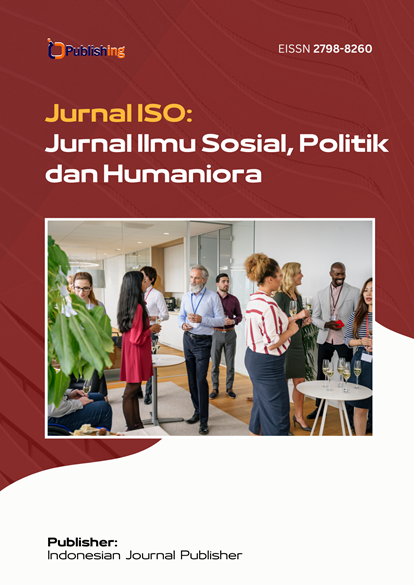The Role of Public Relations in the Television Series "The Boys"
DOI:
https://doi.org/10.53697/iso.v4i2.1990Keywords:
Public relations, Semiotics, Television CodesAbstract
The television series "The Boys" is a series that tells the story of improving the image of a hero by a public relations practitioner. This television series also raises the issue of the life of a hero in the eyes of the public and the media who have a bad image. The purpose of this research is to find out the role of public relations in the character Ashley J. Barrett, played by Colby Minifie in the television series "The Boys". The research method used by researchers is a qualitative method, with a semiotic approach, namely a science that studies signs. The theory used focuses on the level of reality, the level of representation, and the level of ideology of John Fiske's television codes. In this research, the data collection techniques used were literature study, observation and documentation. The results of this research conclude that at the reality level it can be seen in the form of the behavior and appearance of Ashley J. Barrett's character, who is an expert communicator and expert advisor who carries out persuasive communication, showing the role of public relations, and Ashley J. Barrett's appearance tends to be stable when meeting with the public , namely by wearing a formal suit. The level of representation in the form of camera code and dialogue code, and the level of ideology can be seen from the ideology that appears in the television series "The Boys", there is discrimination between the black race and the white race and based on point eight of the international public relations code of ethics.
References
Bartlett, A. (2023). From the tobacco industry’s uses of science for public relations purposes to the alcohol industry: Tobacco industry documents study. Drug and Alcohol Review, 42(5), 1269–1277. https://doi.org/10.1111/dar.13649
Clementson, D. E. (2023). Approaching the public relations profession with ease and ethical expertise: A class project to encourage, equip, and empower students entering the internship market. Communication Teacher, 37(2), 159–170. https://doi.org/10.1080/17404622.2022.2072922
Crouch, W. W. (2023). Organized civil servants: Public employer-employee relations in california. Organized Civil Servants: Public Employer-Employee Relations in California, 1–302. https://www.scopus.com/inward/record.uri?partnerID=HzOxMe3b&scp=85162959137&origin=inward
Duckett, J. (2024). Exploring the use, adoption, and ethics of generative artificial intelligence in the public relations and communication professions. Communication Teacher. https://doi.org/10.1080/17404622.2024.2395312
Feng, Y. (2022). Economic relations and the public image of China in Latin America: a cross-country time-series analysis. Economic and Political Studies, 10(2), 181–207. https://doi.org/10.1080/20954816.2021.1914414
Moleong, Lexy, J. 2011. Metodologi Penelitian Kualitatif. Bandung: PT. Remaja Rosdakarya.
Mulyana, Deddy. 2014. Ilmu Komunikasi: Suatu Pengantar. Bandung: PT. Remaja Rosdakarya.
Mureșan, R. (2021). THE ROLE OF THEORETICAL MODELS OF PUBLIC RELATIONS IN BUILDING THE ETHICAL PROFESSIONAL IDENTITY. Revista Transilvania, 2021(11), 99–104. https://doi.org/10.51391/TRVA.2021.11-12.15.
Qu, W. (2019). Development and validation of a questionnaire to assess public receptivity toward autonomous vehicles and its relation with the traffic safety climate in China. Accident Analysis and Prevention, 128, 78–86. https://doi.org/10.1016/j.aap.2019.04.006
Rock, A. (2023). The Metropolitan Police and the British Film Industry, 1919–1956: Public Relations, Collaboration and Control. The Metropolitan Police and the British Film Industry, 1919–1956: Public Relations, Collaboration and Control, 1–268. https://www.scopus.com/inward/record.uri?partnerID=HzOxMe3b&scp=85189230838&origin=inward
Ruslan, R. (2008). Manajemen PublicRelations dan Media Komunikasi. Jakarta : Rajawali Pers.
Saulnier, A. (2023). Body-worn camera videos and public perceptions of police: an experiment on positive video exposure and community-police relations. Policing and Society, 33(6), 626–642. https://doi.org/10.1080/10439463.2023.2174541
Sobur, A. (2017). Semiotika Komunikasi. Bandung: PT. Remaja Rosdakarya.
Tran, H. L. (2024). BUSINESS JOURNALISM AND PUBLIC RELATIONS: A Delicate Dance. The Routledge Companion to Business Journalism, 267–277. https://doi.org/10.4324/9781003298977-28
Urriza, N. G. (2021). The scope of application of the european freedoms related with family law and the relations between public order of the european union and that of the member states. Cuadernos de Derecho Transnacional, 13(2), 233–255. https://doi.org/10.20318/cdt.2021.6257
Weder, F. (2023). Curating conversations in times of transformation: Convergence in how public relations and journalism are “Doing” communication. Public Relations Inquiry, 12(2), 163–182. https://doi.org/10.1177/2046147X231154550
Yoshikawa, M. (2022). Public relations and outreach from the Hayabusa2 project. Hayabusa2 Asteroid Sample Return Mission: Technological Innovation and Advances, 541–556. https://doi.org/10.1016/B978-0-323-99731-7.00026-X
Zhang, L. (2022). Bridging the communication gap in EU-China relations: policy, media, and public opinion. Asia Europe Journal, 20(3), 219–227. https://doi.org/10.1007/s10308-022-00648-4
Vera, N. (2014). Semiotika dalam Riset Komunikasi. Bogor: Ghalia Indonesia.
Yulianita, N. (2012). Dasar-Dasar Public Relations. Bandung: P2ULPPM UNISBA.
Downloads
Published
How to Cite
Issue
Section
License
Copyright (c) 2024 Rudi Alfianto

This work is licensed under a Creative Commons Attribution 4.0 International License.













